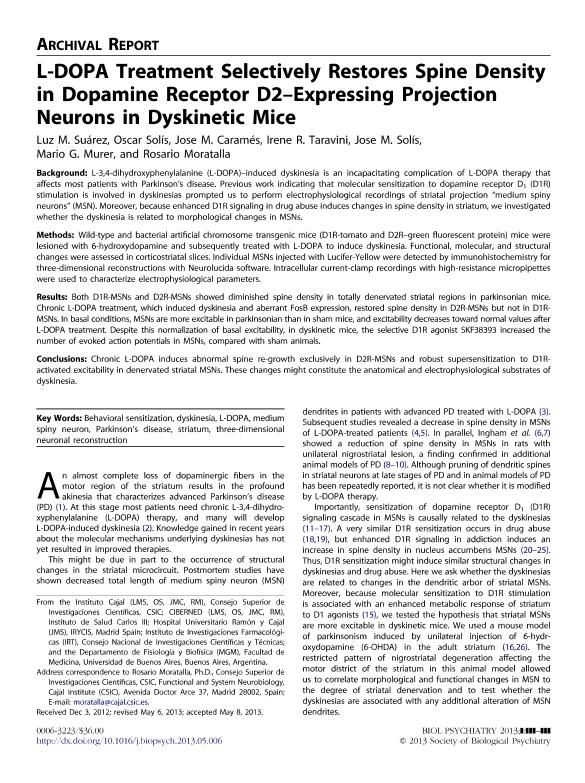Mostrar el registro sencillo del ítem
dc.contributor.author
Suárez, Luz M.
dc.contributor.author
Solís, Oscar
dc.contributor.author
Caramés, Jose M.
dc.contributor.author
Taravini, Irene Rita Eloisa

dc.contributor.author
Solís, Jose M.
dc.contributor.author
Murer, Mario Gustavo

dc.contributor.author
Moratalla, Rosario
dc.date.available
2017-03-07T20:14:14Z
dc.date.issued
2014-05
dc.identifier.citation
Suárez, Luz M.; Solís, Oscar; Caramés, Jose M.; Taravini, Irene Rita Eloisa; Solís, Jose M.; et al.; L-DOPA treatment selectively restores spine density in dopamine receptor d2-expressing projection neurons in dyskinetic mice; Elsevier; Biological Psychiatry; 75; 9; 5-2014; 711-722
dc.identifier.issn
0006-3223
dc.identifier.uri
http://hdl.handle.net/11336/13605
dc.description.abstract
Background: L-3,4-dihydroxyphenylalanine (L-DOPA)–induced dyskinesia is an incapacitating complication of L-DOPA therapy that affects most patients with Parkinson’s disease. Previous work indicating that molecular sensitization to dopamine receptor D1 (D1R) stimulation is involved in dyskinesias prompted us to perform electrophysiological recordings of striatal projection “medium spiny neurons” (MSN). Moreover, because enhanced D1R signaling in drug abuse induces changes in spine density in striatum, we investigated whether the dyskinesia is related to morphological changes in MSNs. Methods: Wild-type and bacterial artificial chromosome transgenic mice (D1R-tomato and D2R–green fluorescent protein) mice were lesioned with 6-hydroxydopamine and subsequently treated with L-DOPA to induce dyskinesia. Functional, molecular, and structural changes were assessed in corticostriatal slices. Individual MSNs injected with Lucifer-Yellow were detected by immunohistochemistry for three-dimensional reconstructions with Neurolucida software. Intracellular current-clamp recordings with high-resistance micropipettes were used to characterize electrophysiological parameters. Results: Both D1R-MSNs and D2R-MSNs showed diminished spine density in totally denervated striatal regions in parkinsonian mice. Chronic L-DOPA treatment, which induced dyskinesia and aberrant FosB expression, restored spine density in D2R-MSNs but not in D1R-MSNs. In basal conditions, MSNs are more excitable in parkinsonian than in sham mice, and excitability decreases toward normal values after L-DOPA treatment. Despite this normalization of basal excitability, in dyskinetic mice, the selective D1R agonist SKF38393 increased the number of evoked action potentials in MSNs, compared with sham animals. Conclusions: Chronic L-DOPA induces abnormal spine re-growth exclusively in D2R-MSNs and robust supersensitization to D1R-activated excitability in denervated striatal MSNs. These changes might constitute the anatomical and electrophysiological substrates of dyskinesia.
dc.format
application/pdf
dc.language.iso
eng
dc.publisher
Elsevier

dc.rights
info:eu-repo/semantics/openAccess
dc.rights.uri
https://creativecommons.org/licenses/by-nc-nd/2.5/ar/
dc.subject
Behavioral Sensitization
dc.subject
Dyskinesia
dc.subject
L-Dopa
dc.subject
Medium Spiny Neuron
dc.subject
Parkinson'S Disease
dc.subject
Striatum
dc.subject
Three-Dimensional Neuronal Recontruction
dc.subject.classification
Neurociencias

dc.subject.classification
Medicina Básica

dc.subject.classification
CIENCIAS MÉDICAS Y DE LA SALUD

dc.title
L-DOPA treatment selectively restores spine density in dopamine receptor d2-expressing projection neurons in dyskinetic mice
dc.type
info:eu-repo/semantics/article
dc.type
info:ar-repo/semantics/artículo
dc.type
info:eu-repo/semantics/publishedVersion
dc.date.updated
2017-03-06T17:07:25Z
dc.journal.volume
75
dc.journal.number
9
dc.journal.pagination
711-722
dc.journal.pais
Países Bajos

dc.journal.ciudad
Ámsterdam
dc.description.fil
Fil: Suárez, Luz M.. Consejo Superior de Investigaciones Cientificas; España
dc.description.fil
Fil: Solís, Oscar. Consejo Superior de Investigaciones Cientificas; España
dc.description.fil
Fil: Caramés, Jose M.. Consejo Superior de Investigaciones Cientificas; España
dc.description.fil
Fil: Taravini, Irene Rita Eloisa. Consejo Nacional de Investigaciones Científicas y Técnicas. Oficina de Coordinación Administrativa Houssay. Instituto de Investigaciones Farmacológicas (i); Argentina
dc.description.fil
Fil: Solís, Jose M.. Hospital Universitario Ramón y Cajal; España
dc.description.fil
Fil: Murer, Mario Gustavo. Consejo Nacional de Investigaciones Científicas y Técnicas. Oficina de Coordinación Administrativa Houssay. Instituto de Fisiología y Biofísica Bernardo Houssay; Argentina. Universidad de Buenos Aires. Facultad de Medicina; Argentina
dc.description.fil
Fil: Moratalla, Rosario. Consejo Superior de Investigaciones Cientificas; España
dc.journal.title
Biological Psychiatry

dc.relation.alternativeid
info:eu-repo/semantics/altIdentifier/url/http://www.sciencedirect.com/science/article/pii/S0006322313004162
dc.relation.alternativeid
info:eu-repo/semantics/altIdentifier/doi/http://dx.doi.org/10.1016/j.biopsych.2013.05.006
Archivos asociados
